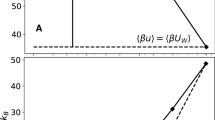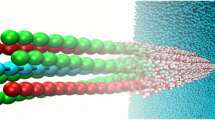Abstract
At nanoscale, atomistic simulation is widely used for investigating crystalline chitin fibers, the structural component for many biological materials. However, the longitudinal dimension of naturally occurring chitin fibers exceeds hundreds of nanometer, beyond the investigation range of all-atom simulation due to the limitation of computational power. Under this context, coarse-grained simulation is a useful alternative that facilitates the investigation of a large system. We develop a coarse-grained model for describing the structural and mechanical properties of α-chitin. The developed coarse-grained model can reasonably predict these properties. Moreover, this model is consistent with existing coarse-grained force fields for proteins. The present model of α-chitin possesses good potential and applicability in the investigation of natural chitin-based materials at the length scale of several hundred nanometers.

Mapping atomistic α-chitin model into a coarse-grained modelᅟ






Similar content being viewed by others
References
Sikorski P, Hori R, Wada M (2009) Revisit of α-chitin crystal structure using high resolution X-ray diffraction data. Biomacromolecules 10(5):1100–1105
Petrov M, Lymperakis L, Friák M, Neugebauer J (2013) Ab initio based conformational study of the crystalline α-chitin. Biopolymers 99(1):22–34
Franca EF, Lins RD, Freitas LC, Straatsma T (2008) Characterization of chitin and chitosan molecular structure in aqueous solution. J Chem Theory Comput 4(12):2141–2149
Nikolov S, Petrov M, Lymperakis L, Friák M, Sachs C, Fabritius H-O, Raabe D, Neugebauer J (2010) Revealing the design principles of high-performance biological composites using ab initio and multiscale simulations: the example of lobster cuticle. Adv Mater 22(4):519–526
Vincent JF, Wegst UG (2004) Design and mechanical properties of insect cuticle. Arthropod Struct Dev 33(3):187–199
Saranathan V, Osuji CO, Mochrie SG, Noh H, Narayanan S, Sandy A, Dufresne ER, Prum RO (2010) Structure, function, and self-assembly of single network gyroid (I4132) photonic crystals in butterfly wing scales. Proc Natl Acad Sci 107(26):11676–11681
Miserez A, Li Y, Waite JH, Zok F (2007) Jumbo squid beaks: inspiration for design of robust organic composites. Acta Biomater 3(1):139–149
Politi Y, Priewasser M, Pippel E, Zaslansky P, Hartmann J, Siegel S, Li C, Barth FG, Fratzl P (2012) A Spider’s fang: how to design an injection needle using chitin-based composite material. Adv Funct Mater 22(12):2519–2528
Chen P-Y, Lin AY-M, McKittrick J, Meyers MA (2008) Structure and mechanical properties of crab exoskeletons. Acta Biomater 4(3):587–596. doi:10.1016/j.actbio.2007.12.010
Guvench O, Mallajosyula SS, Raman EP, Hatcher E, Vanommeslaeghe K, Foster TJ, Jamison FW, MacKerell AD Jr (2011) CHARMM additive all-atom force field for carbohydrate derivatives and its utility in polysaccharide and carbohydrate–protein modeling. J Chem Theory Comput 7(10):3162–3180
Huang J, MacKerell AD (2013) CHARMM36 all-atom additive protein force field: validation based on comparison to NMR data. J Comput Chem 34(25):2135–2145
Oostenbrink C, Villa A, Mark AE, Van Gunsteren WF (2004) A biomolecular force field based on the free enthalpy of hydration and solvation: the GROMOS force‐field parameter sets 53A5 and 53A6. J Comput Chem 25(13):1656–1676
Beckham GT, Crowley MF (2011) Examination of the α-chitin structure and decrystallization thermodynamics at the nanoscale. J Phys Chem B 115(15):4516–4522
Jin K, Feng X, Xu Z (2013) Mechanical properties of chitin–protein interfaces: a molecular dynamics study. BioNanoScience 3(3):312–320. doi:10.1007/s12668-013-0097-2
Yu Z, Xu Z, Lau D (2014) Effect of acidity on chitin–protein interface: a molecular dynamics study. BioNanoScience 4(3):207–215. doi:10.1007/s12668-014-0138-5
Muzzarelli RA (2011) Chitin nanostructures in living organisms. In: Gupta NS (ed) Chitin, vol 34. Topics in geobiology. Springer, Dordrecht, pp 1–34. doi:10.1007/978-90-481-9684-5_1
Molinero V, Goddard WA (2004) M3B: a coarse grain force field for molecular simulations of malto-oligosaccharides and their water mixtures. J Phys Chem B 108(4):1414–1427
Liu P, Izvekov S, Voth GA (2007) Multiscale coarse-graining of monosaccharides. J Phys Chem B 111(39):11566–11575
Fukunaga H, Takimoto J-i, Doi M (2002) A coarse-graining procedure for flexible polymer chains with bonded and nonbonded interactions. J Chem Phys 116(18):8183–8190
Müller-Plathe F (2002) Coarse-graining in polymer simulation: from the atomistic to the mesoscopic scale and back. Chem Phys Chem 3(9):754–769
Tschöp W, Kremer K, Batoulis J, Bürger T, Hahn O (1998) Simulation of polymer melts. I. Coarse‐graining procedure for polycarbonates. Acta Polym 49(2–3):61–74
Marrink SJ, Risselada HJ, Yefimov S, Tieleman DP, de Vries AH (2007) The MARTINI force field: coarse grained model for biomolecular simulations. J Phys Chem B 111(27):7812–7824
Monticelli L, Kandasamy SK, Periole X, Larson RG, Tieleman DP, Marrink S-J (2008) The MARTINI coarse-grained force field: extension to proteins. J Chem Theory Comput 4(5):819–834
López CA, Rzepiela AJ, De Vries AH, Dijkhuizen L, Hünenberger PH, Marrink SJ (2009) Martini coarse-grained force field: extension to carbohydrates. J Chem Theory Comput 5(12):3195–3210
Reith D, Pütz M, Müller-Plathe F (2003) Deriving effective mesoscale potentials from atomistic simulations. J Comput Chem 24(13):1624–1636
Plimpton S (1995) Fast parallel algorithms for short-range molecular dynamics. J Comput Phys 117(1):1–19
Jorgensen WL, Chandrasekhar J, Madura JD, Impey RW, Klein ML (1983) Comparison of simple potential functions for simulating liquid water. J Chem Phys 79(2):926–935. doi:10.1063/1.445869
Rühle V, Junghans C, Lukyanov A, Kremer K, Andrienko D (2009) Versatile object-oriented toolkit for coarse-graining applications. J Chem Theory Comput 5(12):3211–3223
Humphrey W, Dalke A, Schulten K (1996) VMD: visual molecular dynamics. J Mol Graph 14(1):33–38
Wohlert J, Berglund LA (2011) A coarse-grained model for molecular dynamics simulations of native cellulose. J Chem Theory Comput 7(3):753–760
Park S, Khalili-Araghi F, Tajkhorshid E, Schulten K (2003) Free energy calculation from steered molecular dynamics simulations using Jarzynski’s equality. J Chem Phys 119:3559
Ehrlich H, Worch H (2007) Sponges as natural composites: from biomimetic potential to development of new biomaterials. Museu National, Rio de Janeiro, pp 303–312
Ehrlich H, Simon P, Carrillo-Cabrera W, Bazhenov VV, Botting JP, Ilan M, Ereskovsky AV, Muricy G, Worch H, Mensch A (2010) Insights into chemistry of biological materials: newly discovered silica-aragonite-chitin biocomposites in demosponges. Chem Mater 22(4):1462–1471
Acknowledgment
The authors are grateful to the support from Croucher Foundation through the Start-up Allowance for Croucher Scholars with the Grant No. 9500012, and the support from the Research Grants Council (RGC) in Hong Kong through the Early Career Scheme (ECS) with the Grant No. 139113.
Author information
Authors and Affiliations
Corresponding author
Electronic supplementary material
Below is the link to the electronic supplementary material.
ESM 1
A file containing the coarse-grained parameters of all the bonds, angles dihedrals as well as the non-bonded interactions is available online along with the electronic version. The settings of coarse-grained protein models are referred from online coarse-graining tutorial (http://www.ks.uiuc.edu/Training/Tutorials/martini/rbcg-tutorial.pdf). (DOCX 18 kb)
Rights and permissions
About this article
Cite this article
Yu, Z., Lau, D. Development of a coarse-grained α-chitin model on the basis of MARTINI forcefield. J Mol Model 21, 128 (2015). https://doi.org/10.1007/s00894-015-2670-9
Received:
Accepted:
Published:
DOI: https://doi.org/10.1007/s00894-015-2670-9




